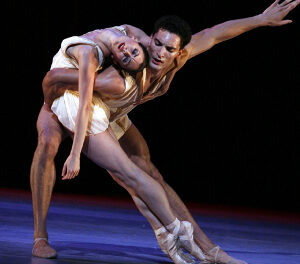With her flaming red hair, sly glances, and jet-black pantsuit, there’s something devilish about violinist Aisslinn Nosky, from the moment she first appears. Yet this effect was further accentuated at her Charlotte Bach Festival recital when she tore into the fastest movements of her Bach and Telemann selections, playing them with wicked glee. Most fearsome were those unexpected, seemingly supernatural episodes when Nosky sustained two melodies simultaneously with her bow. Paradoxically, there is a shy side to this charismatic virtuoso, for her soft-spoken introductions were often inaudible, even though she had a microphone in her hand – and her spoken intro on her history with Bach’s Partita No. 3, in E, revealed fits of self-doubt and possibly stagefright. Say what you will about Nosky’s charismatic quirks, this was not a boring evening at Christ Church Charlotte. There were even some contemporary touches as Nosky dipped into Michael Oesterle‘s Stand Still, a piece commissioned by the soloist.
Beginning with Sonata No. 1, Nosky made it clear that she wasn’t going to take an Arthur Grumiaux adoration-of-the-melody approach to the opening Adagio, sprinkling some very clean double-bowing into her swifter interpretation and projecting an authentically tart tone. Similarly, the Fuga was delivered in slightly accelerated, straight-ahead style, dazzlingly juggling two melodies simultaneously when they occurred but without any gradual crescendos that might have given the movement a more dramatic architecture. When the final Presto arrived, it was impossible not to be swept away by Nosky’s bravado and joy.
For just a second, the three-note cluster that launched Part I of Oesterle’s Stand Still reminded me of a weepy passage in Vivaldi’s Four Seasons, but its more characteristic mode, fitfully injected into the piece’s volatile texture, evoked the fiddling of Appalachia, the kind of virtuosity that Nosky could revel in. Pauses toward the end seemed longer than you will hear on Nosky’s Bach, Ysaÿe, Oesterle recording from 2012. Instead of switching violins for the piece, she exchanged bows, going with the longer stick prescribed by the composer. Part III, played after the Telemann, resumed the bluegrass sound, though it seemed to be leaning toward jazz at the beginning and briefly nodding toward Bach at the end.
As a longtime member of Toronto-based Tafelmusik, it was natural to expect that Nosky would have a special affinity for Georg Philipp Telemann, since the baroque ensemble is named after that composer’s most famous work. Nosky’s intro hinted at the affection she has for Telemann, and the verve with which she played his Fantasie No. 7 in E-flat was particularly evident in the fast, even-numbered movements, the Allegro and then the concluding Presto, both brimming with folksy merriment and light. Although the penultimate Largo could have been a little more ardent, the opening Dolce was very sweet indeed with just a touch of lovely double-bowing. Rachel Podger has probably given us the best of the few recordings we have of this piece, but the engineering didn’t equal the artistry, so Nosky’s live performance was an even more satisfying experience.
The Charlotte Bach Festival program booklet was marred with errors for this concert, getting Telemann’s middle name wrong for starters, but the most puzzling blunder was the listing of Bach’s Partita No. 3 as his Sonata No. 1 – the work that Nosky had already played. The Partita had been on the aforementioned 2012 recording if anybody had wished to check, but at least the individual movements were listed correctly. Whatever Nosky’s history with the piece, defeating her self-doubts or not, the violinist was perhaps too eager to debunk the stagefright hypothesis, tackling the faster movements at a pace that occasionally blurred their beauties. After the slightly rushed Preludio, the Loure movement was Nosky’s most lyrical effort of the evening. Where the Gavotte en Rondeaux contained Bach’s delightful contrapuntal overlap, Nosky was at her best in sustaining the two strands. Her double-bowing in the Menuets was piercing and exquisite in its precision, but she let the tempo of the Bourée run away from her a little, so it didn’t really dance. Maybe the natural tempo of Bach’s concluding Gigue caught up with the pace Nosky was setting, or maybe seeing the end in view relaxed her a little. Either way, Bach and Nosky finished perfectly aligned. No encore on this occasion, but she’ll be the North Carolina Baroque Orchestra’s concertmaster as this year’s Charlotte Bach Festival concludes with performances of the St. Matthew Passion on successive nights in Chapel Hill and then Charlotte.












